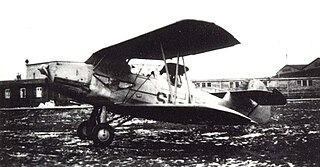
The Heinkel He 111 is a German airliner and bomber designed by Siegfried and Walter Günter at Heinkel Flugzeugwerke in 1934. Through development, it was described as a "wolf in sheep's clothing". Due to restrictions placed on Germany after the First World War prohibiting bombers, it was presented solely as a civil airliner, although from conception the design was intended to provide the nascent Luftwaffe with a heavy bomber.

The Focke-Wulf Ta 154 Moskito was a fast twin-engined German night fighter aircraft designed by Kurt Tank and produced by Focke-Wulf during late World War II. Only a few were produced, proving to have less impressive performance than the prototypes.

The Blohm & Voss BV 155 was a German high-altitude interceptor aircraft intended to be used by the Luftwaffe against raids by USAAF Boeing B-29 Superfortresses. Work started on the design as the Messerschmitt Me 155 in 1942, but the project went through a protracted development period and change of ownership, and prototypes were still under test and development when World War II ended.

The Junkers Ju 287 was a multi-engine tactical jet bomber built in Nazi Germany in 1944. It featured a novel forward-swept wing, and the first two prototypes were among the very few jet propelled aircraft ever built with fixed landing gear.

The Junkers Ju 390 was a German long-range derivative of the Junkers Ju 290 aircraft, intended to be used as a heavy transport aircraft, maritime patrol aircraft and long-range bomber. It was one of the aircraft designs submitted for the abortive Amerikabomber project, along with the Messerschmitt Me 264, the Focke-Wulf Ta 400 and the Heinkel He 277.

The Junkers Ju 290 was a large German, four-engine long-range transport, heavy bomber and maritime patrol aircraft used by the Luftwaffe late in World War II that had been developed from an earlier airliner.

The Dornier Do 24 is a 1930s German three-engine flying boat designed by the Dornier Flugzeugwerke for maritime patrol and search and rescue. A total of 279 were built among several factories from 1937 to 1945.

The Junkers Ju 86 was a German monoplane bomber and civilian airliner designed in the early 1930s, and employed by various air forces on both sides during World War II. The civilian model Ju 86B could carry ten passengers. Two were delivered to Swissair and five to Deutsche Luft Hansa. In addition a single civilian Ju 86Z was delivered to Sweden's AB Aerotransport.

The Arado Ar 66 was a German single-engined, two-seat training biplane, developed in 1933. It was also used for night ground-attack missions on the Eastern Front. It was engineer Walter Rethel's last design in collaboration with Arado, before Walter Blume, assigned as Arado Flugzeugwerke's chief design engineer in 1933, took over the bulk of the Arado firm's design duties.

The Heinkel He 59 was a twin-engined German biplane designed in 1930, resulting from a requirement for a torpedo bomber and reconnaissance aircraft able to operate on wheeled landing gear or twin-floats.

The Fieseler Fi 167 was a 1930s German biplane torpedo and reconnaissance bomber designed for use from the Graf Zeppelin class aircraft carriers under construction from 1936 to 1942.

The Junkers W 34 was a German-built, single-engine, passenger and transport aircraft. Developed in the 1920s, it was taken into service in 1926. The passenger version could take a pilot and five passengers.

The Junkers Ju 252 was a German cargo aircraft that made its first flight in late October 1941. The aircraft was planned as a replacement for the Junkers Ju 52/3m in commercial airline service, but only a small number were built as cargo aircraft for the Luftwaffe.

The Henschel Hs 130 was a German high-altitude reconnaissance and bomber aircraft developed in World War II. It suffered from various mechanical faults and was never used operationally, only existing as prototype airframes.

The Junkers Ju 488 was a proposed four-engined German heavy strategic bomber under development in World War II. It was based on the twin-engined Ju 188 series but with additional engines mounted on a new wing inner section. One prototype was begun but never finished.

The Ambrosini SAI.403 Dardo ("Dart") was a light fighter aircraft built in Italy during World War II.

The Arado Ar 76 was a German aircraft of the 1930s, designed as a light fighter with a secondary role as an advanced trainer in mind.

The Letov Š-28 was a Czechoslovak single-engined, two-seat reconnaissance aircraft. It was manufactured by Letov Kbely in a number of versions with different powerplants. The most important version was the Š-328, which was produced in relatively high quantities.

The Letov Š-31 was a fighter aircraft produced in Czechoslovakia in the early 1930s in a number of variants. All of the aircraft had metal tubular framing and fabric covering with a metal engine cowling.
The Letov L-101 was an airliner designed in Czechoslovakia shortly after the end of the Second World War. It was to have been a 12-seat twin-engine feederliner, built using German engines left over from Czechoslovakia's occupation. The Letov factory was nationalised on 24 October 1945, and the L-101 was its first project, along with finishing work on the Junkers Ju 290.



















